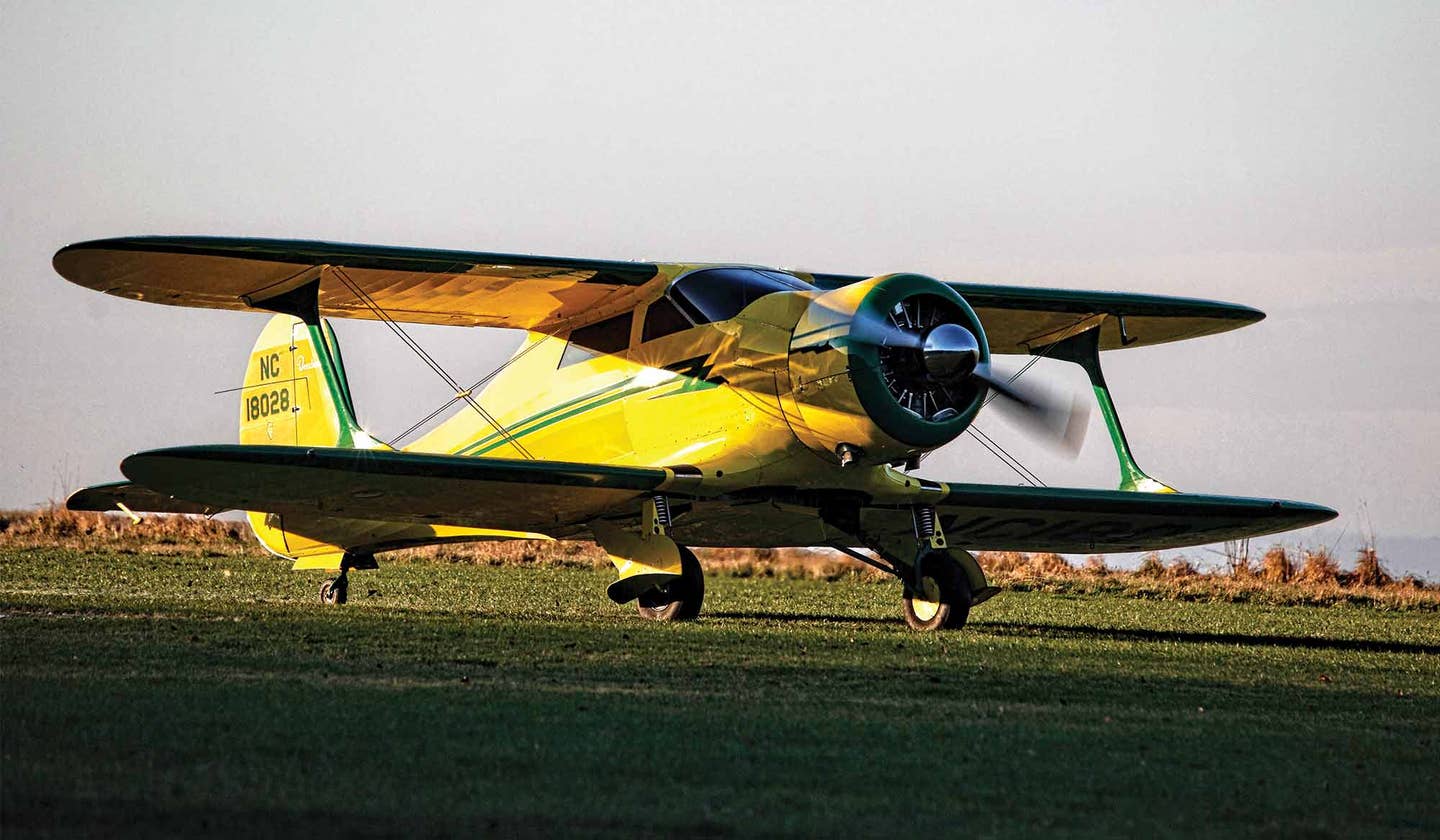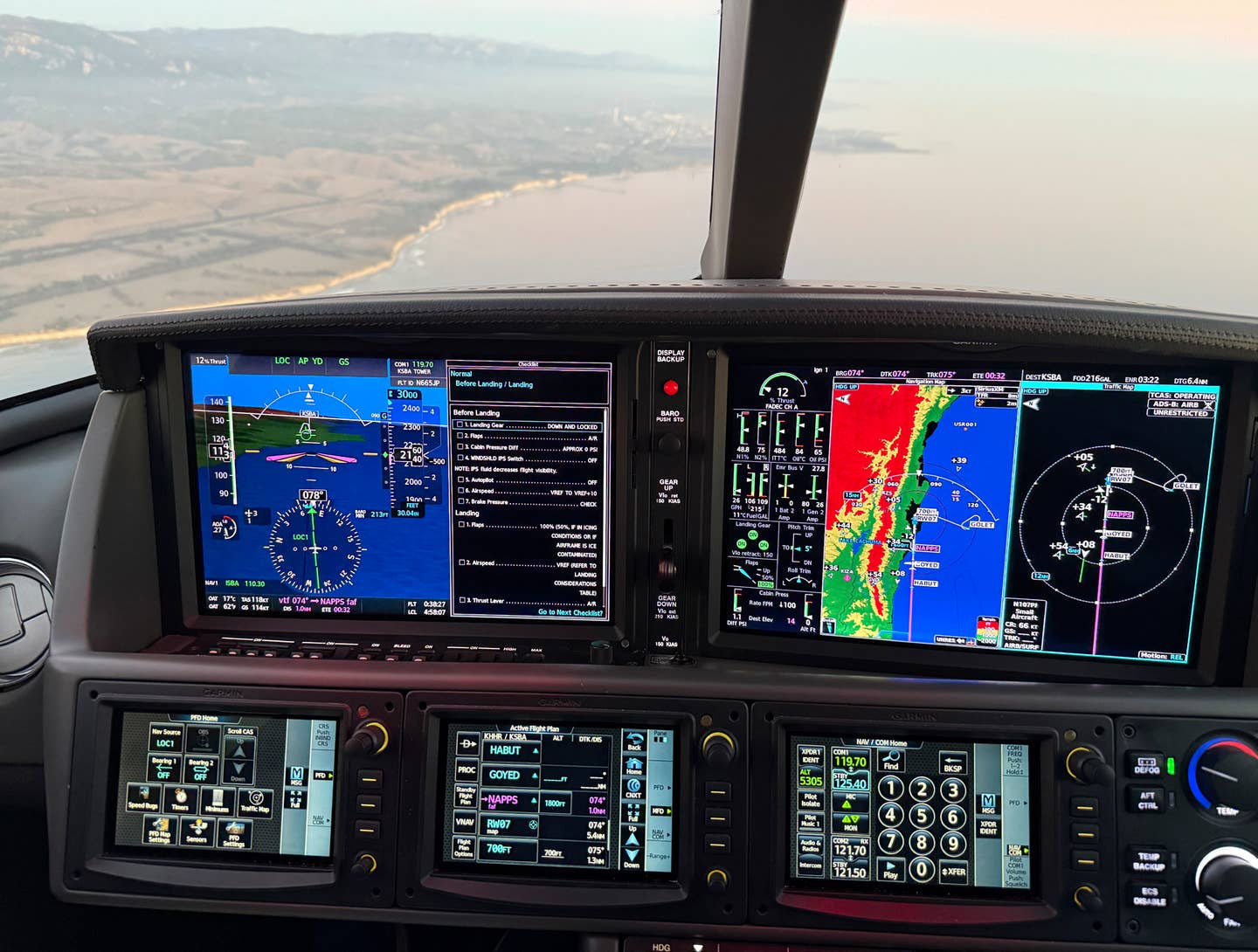
A Beech D17S Staggerwing getting ready for an afternoon flight. Alamy
Recently a friend sent me a blurb from another aviation magazine about the restoration of a Beech Staggerwing — arguably the ultimate classic airplane — by the Kansas Aviation Museum. He knew I’d be interested in this particular D17S because it belonged at one time to my ex- and late husband, Ebby Lunken.
Unfortunately, when it comes to hands-on experience with these magnificent creatures (Staggerwings, not husbands … well, maybe husbands too) I’ve always been a day late and a dollar short. Some years before I knew him, Ebby bought the airplane from Goodyear, but ended up selling the salvage after having an unfortunate and “complicated” (but injury-free) prang in Michigan. But I vividly remember the magnificent oil painting of the iconic Bimini-blue biplane in flight that hung in our living room near another painting of N151Q, his Cavalier conversion P-51 (also blue and cream because Ebby thought all airplanes should be painted blue). I’m pretty sure I fell in love with him before we even met after seeing him take off in N151Q. The P-51 was sold to buy four Lockheed 10As for his less-than-successful but hugely fun-while-it-lasted Midwest Airways.
Most surviving Staggerwings have a “past,” but the one I watched being restored at Lunken Airport in the 1990s was downright promiscuous. First flown by the military in World War II and then the CAA, in 1946 she began a shuttle through no fewer than 19 owners, in more than 11 states. Forty-five years later, the logbooks listed 1,640 hours, with only 238 on the Pratt & Whitney R-985 engine. In 1990, T.W. Smith, Neal Schaefer and Bobby Strunk bought her from another restorer in Florida. They trucked her to Lunken, and she lived for years in a skunk works in the back of what’s now the Signature Engines hangar. Most of the brains and the labor were the product of Neal’s father, Tom Schaefer, who’s as expert and as meticulous a craftsman as God ever made. Even with help, it was a massive undertaking, and I remember thinking, after an old hand named Charlie Petrou finished the woodwork, it was almost too beautiful to cover.
Re-covering a Staggerwing is not for the fainthearted. With a cruise speed in excess of 200 mph, something like 6,000 rib stitches are required to secure the fabric. Somebody calculated that, with one stitch every three minutes — that’s an expert, working nonstop, at full speed — you can finish 20 stitches in an hour. At minimum (slave) wages of $20 per hour, it would cost over $6,000 for the rib stitching alone. Definitely not a first-timer’s project.
It would be 11 years before the magnificent red, maroon and gold-trimmed beauty with a newly overhauled R-985 belched smoke and fire and roared to life at Lunken. The guys put about 50 hours on N1532V, including four trips to Oshkosh and a couple to Tullahoma, before 2005, when they sold her to a dealer in Australia. He had her disassembled, crated and shipped across the Pacific, but when the airplane didn’t sell by early 2007, she was again “undressed,” re-crated and shipped back to California, hopefully for a buyer in the States. Within six months she went to — you guessed it — another Australian named Mark Fitzgerald, who disassembled, crated and floated her back Down Under. Then, in 2010, he sold the fickle lady to Chris Shine in Western Australia (at least on the same continent), who flew her for about 100 hours, until a master rod failed in May 2014. Shine did a magnificent job of stuffing the big airplane into a small field, thankfully suffering only minor injuries. But now, the ship, designated VH-FNS, was a basket case.
The next target in this ongoing tale of seduction was an airline pilot, Cam Hawley, and his wife, Tracey, who were hoping to rescue and restore Admiral Byrd’s historic Antarctic expedition Staggerwing. But that airplane, in pieces in the Australian Outback, wasn’t salvageable, so the Hawleys are currently restoring the broken but repairable VH-FNS, and even using some parts and pieces from the iconic Byrd airplane. It just so happens the shady (but beautiful) lady with the unsavory past will fly again.
Why all the prangs? Well, it’s said the Staggerwing was the most complex single-engine airplane ever conceived — every one handcrafted and slightly different. The early B models had lousy ground-handling characteristics, but later D, E and G models were not only better behaved but better performers, with a lengthened fuselage, conventional brakes and a retractable tailwheel. The airplanes were powered with everything from the 285 hp Jacobs to the 600 hp Pratt & Whitney, but the 450 hp R-985 was most popular and made for a helluva ship. As we all know, Mr. and Mrs. Beech built some magnificent airplanes (think Staggerwing and Bonanza), purchased by pilots wealthy enough to afford them but not always smart enough to realize and respect their limits.
I don’t know the N-number of Ebby’s Staggerwing, or even the exact dates he owned it — sometime in the mid-1950s — but I distinctly remember the story he told me of what happened, and the rather far-reaching consequences.
I should preface the story by saying that everybody involved has long flown off to the Great Staggerwing Convention in the Sky.
It seems Ebby, Ohio Wing commander of the Civil Air Patrol, told his first wife, Dorothy, that he and a pilot and race-car friend, Charlie Hassan (also married), were taking the Staggerwing to Washington for a national CAP conference. It was midwinter, and they somehow ended up instead in Gaylord, Michigan, skiing with two beautiful, socially prominent single ladies with iconic last names like Ford and Chapin.
After an idyllic weekend on the slopes and around the fireplace in the ski lodge, they loaded up the Staggerwing and launched from Gaylord for Cincinnati, planning a stop in Detroit to drop off Sarah and Melanie. The runway at Gaylord had been plowed, but snow piles on either side were close to the runway edges and the Staggerwing has a rather wide wingspan. Ebby said it happened as if in slow motion — the wings struck the snowbanks, and the airplane unhurriedly but inexorably nosed over until it came to rest upside-down on the runway. Shutting everything down and warning everybody to be careful about unfastening their seat belts (lest they fall on their heads), he and Charlie and the ladies got out safely.
Naturally, the press arrived and got some great shots of the upside-down airplane; requests for interviews were less than politely declined. Although the airplane was bent, everybody, thankfully, came away unscathed — well, sort of.
Ebby showed me the clippings from the Detroit Free Press and Cincinnati Times-Star, photos and headlines something like “Cincinnati Industrialist and Friends Narrowly Escape Tragedy in Ski Holiday Airplane Crash.”
Regrettably but inevitably, Mrs. Lunken and Hassan also saw the photos and headlines.
Airport folklore says both women met their soon-to-be ex-husbands at the airport gate, wielding bottles of soda water, which they smashed over the men’s heads.
True? Not sure. Anyhow, about six years later, that’s how I became the second Mrs. Lunken.

Sign-up for newsletters & special offers!
Get the latest FLYING stories & special offers delivered directly to your inbox






